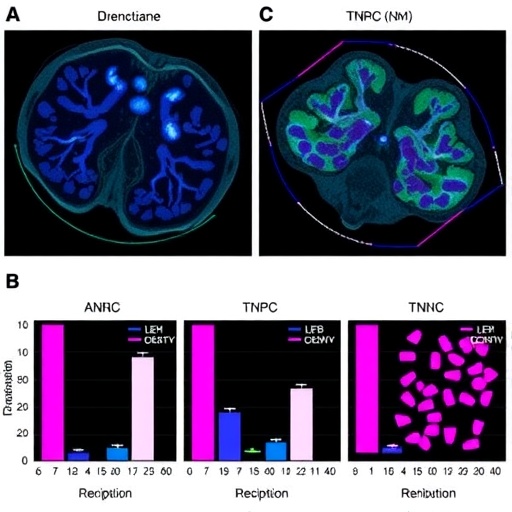PROTECT YOUR DNA WITH QUANTUM TECHNOLOGY
Orgo-Life the new way to the future Advertising by AdpathwayIn a groundbreaking study published in BMC Genomics, researchers have meticulously explored the trihelix transcription factor family in cucumber, a plant species of critical agricultural significance. The paper, authored by Xie, Xue, and Chen, among others, sheds light on the complex ways in which these transcription factors contribute to the plant’s responses to biotic stress. This research not only advances our understanding of plant molecular biology but could also play a vital role in developing more resilient crop varieties in the face of increasing environmental challenges.
The trihelix transcription factor family is known for its unique structural characteristics, particularly the trihelix motif that allows these proteins to bind to specific DNA sequences and influence gene expression. This study aimed to conduct a genome-wide identification of trihelix transcription factors in cucumber, providing insights into their distribution, evolutionary background, and functional roles. Through advanced bioinformatics techniques, the team was able to identify multiple members of the trihelix family, each varying in their expression patterns across different developmental stages and in response to environmental stressors.
Cucumis sativus, commonly known as cucumber, is cultivated globally and is widely consumed for its nutritional benefits. However, cucumbers are also susceptible to a variety of biotic stresses, such as viral infections and pest attacks. Understanding the molecular mechanisms behind cucumber’s resistance can provide a foundation for improving plant resilience through biotechnological approaches. The study’s authors meticulously analyzed gene expression patterns of the identified trihelix transcription factors under various stress conditions, unveiling a rich tapestry of regulatory networks at play.
What makes this research particularly significant is the role of trihelix transcription factors in mediating plant responses to pathogens. The authors found that specific trihelix genes were upregulated in response to viral stress, indicating their defensive roles. This aligns with previous studies in other plant species, suggesting a conserved mechanism of biotic stress response across the plant kingdom. The identification of these key players in cucumber’s stress response opens new avenues for research and potential applications in plant breeding programs aimed at enhancing disease resistance.
The methodology employed in this study merged genomic analysis with expression profiling techniques. By utilizing publicly available genomic databases and RNA-sequencing data, the researchers were able to create a comprehensive overview of the trihelix transcription factors in cucumber. In addition, their rigorous statistical analyses provided compelling evidence for the functional significance of these transcription factors in biotic stress responses. The robustness of their experimental approach underscores the reliability of their findings and paves the way for future exploratory research.
In addition to identifying the trihelix transcription factors, the study also delves into the evolutionary aspects of this gene family. By comparing cucumber’s trihelix genes with those found in other dicots and monocots, the authors present a phylogenetic tree that elucidates the evolutionary relationships and diversification patterns of these transcription factors. Such information is invaluable as it enhances our understanding of how plants have adapted over time to their environments and their intrinsic threats.
As agricultural practices face the dual challenges of climate change and evolving pest and pathogen populations, the insights gained from this research could be pivotal in developing strategies that enhance crop resilience. The ability to manipulate the expression of trihelix transcription factors could lead to cucumbers and other crops that are better equipped to handle stressors, ultimately supporting food security in a rapidly changing world.
Moreover, this research aligns with a broader trend in plant science towards understanding the intersection of genetics, genomics, and biotechnology. Harnessing the power of molecular markers associated with stress resistance can significantly expedite traditional breeding efforts, enabling researchers and agronomists to produce superior crop varieties in a shorter timeframe. The practical implications of discovering key transcription factors should not be underestimated — they could lead to tangible benefits for farmers and food producers.
The authors also emphasize the need for further functional studies to uncover the specific mechanisms by which trihelix transcription factors exert their effects. Future experiments could involve gene knockout or overexpression studies in model plant systems, allowing researchers to validate the roles of these transcription factors in vivo. Such studies would contribute to a more nuanced understanding of plant physiology and the intricate web of gene regulation that protects plants from biotic stresses.
In summary, the comprehensive analysis of trihelix transcription factors in cucumber presented in this study provides a significant contribution to plant molecular biology. With an emphasis on both genome-wide identification and expression analysis, the insights gleaned from Xie and colleagues’ work are poised to impact future research and agricultural practices. As the scientific community continues to unravel the complexities of plant stress responses, findings such as these will play an essential role in the development of innovative solutions to ensure sustainable and resilient crop production.
The implications of this research extend beyond cucumbers alone; it underscores a vital principle in agricultural science — that understanding genetic pathways and regulatory networks can empower us to create robust crops. As challenges such as climate change and global food shortages loom, the quest for resilient agricultural strategies becomes increasingly urgent. The trihelix transcription factors identified in this study represent just a piece of the puzzle, but they are a crucial one, highlighting the intricate interplay between a plant’s genetics and its environment.
As we look toward the future of agricultural innovation, studies like this remind us of the importance of genomic research and its potential to integrate with traditional breeding practices, creating hybrid approaches that could transform how we cultivate our food. Increasing the resilience of crops through fundamental research offers the promise of food systems that can withstand both biotic and abiotic stresses, reflecting the dynamic challenges faced in sustainable agriculture.
This research, with its thorough analysis and groundbreaking findings, is sure to inspire future efforts in the field of plant science, reinforcing the need for continued exploration of transcription factors across various species. As the capabilities of genomic tools expand, so too will our ability to manipulate plant genomes for improved performance under stress, leading us toward a resilient agricultural future where food security is ensured.
Subject of Research: Trihelix transcription factors in cucumber and their role in biotic stress responses.
Article Title: Genome-wide identification and expression analysis of trihelix transcription factor family in cucumber (Cucumis sativus L.) and their roles in biotic stress responses.
Article References:
Xie, T., Xue, X., Chen, L. et al. Genome-wide identification and expression analysis of trihelix transcription factor family in cucumber (Cucumis sativus L.) and their roles in biotic stress responses.
BMC Genomics (2025). https://doi.org/10.1186/s12864-025-12341-y
Image Credits: AI Generated
DOI: 10.1186/s12864-025-12341-y
Keywords: trihelix transcription factors, Cucumis sativus, biotic stress responses, genome-wide identification, gene expression, agricultural resilience.
Tags: agricultural significance of Cucumis sativusbioinformatics in plant researchcucumber biotic stress responsescucumber crop resilience developmentenvironmental stress impact on cucumbersevolutionary background of transcription factorsgene expression regulation in plantsgenome-wide identification of trihelix factorsnutritional benefits of cucumbersplant molecular biology advancementsstructural characteristics of trihelix proteinstrihelix transcription factors in cucumber


 6 hours ago
6
6 hours ago
6





















 English (US) ·
English (US) ·  French (CA) ·
French (CA) ·